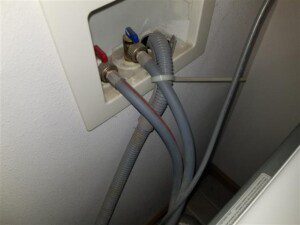
When a Home Inspector inspects a home, they will inspect the visible portion of the water distribution system, and look for any issues including active water leaks or any potential issues that could lead to water leaks. Inspection of any water pipes that cannot be visually inspected, such as inside walls, buried under insulation, or buried underground, are not part of the scope of a general home inspection. Most home inspectors will disclaim inspection of these components, since they cannot be observed. However, inspection of the visible portion of a water supply system can provide clues about the general condition of the system, including the type of materials used, age and condition.

Rubber washer hoses are more likely to break.
Although the standards of practice for home inspections does not include inspection of washing machines or dryers, some home inspectors will often report when they find non-reinforced rubber supply hoses installed at washing machines, since they are known to leak and in many cases burst. Rubber hosing for washing machines was the standard for many years, but as technology and materials improved, manufacturers developed reinforced rubber hoses, which are way more durable and reliable. The most durable type of reinforced rubber hose is a stainless steel braided hose.
Non-reinforced rubber hoses are vulnerable to failure due to wear and tear caused by high water pressure and hydraulic shock known as water hammer. Water hammer is when water pressure in a hose changes after a washer cycle completes. When this happens continuously over a period of time, the rubber can expand and contract to the point where the material will crack and break. Once this happens, a substantial amount of water can spray into the home. For most homes, residential water pressure is between 40 – 80 psi, so in a matter of minutes a burst water hose could allow hundreds of gallons to flow into the home. When a rubber hose is reinforced, the rubber is less likely to flex to the point where it will break. Installation of reinforced washer hoses can significantly reduce the risk of bursting of hoses, and therefore are the best choice for your home.
Check out the video below for more information how to replace rubber hoses with stainless steel braided hoses.
